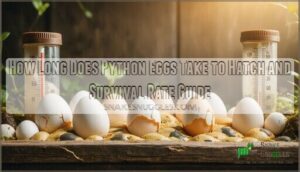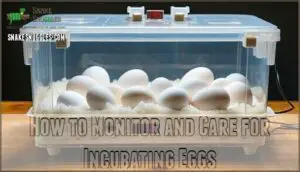This site is supported by our readers. We may earn a commission, at no cost to you, if you purchase through links.

Most python eggs hatch in 49 to 90 days, depending on the species and incubation conditions. Ball pythons need about 55–60 days, while reticulated pythons can stretch up to 90.
With steady temperatures (88–90°F) and humidity (85–95%), survival rates can reach 80–90% in captivity. That’s much better than their odds in the wild.
Every clutch tells a story—sometimes with a few surprises if you’re not watching closely.
Table Of Contents
- How Long for Python Eggs to Hatch?
- What Affects Python Egg Incubation Time?
- Optimal Incubation Conditions for Python Eggs
- Incubation Methods: Maternal Vs. Artificial
- Stages of Python Egg Development
- How to Monitor and Care for Incubating Eggs
- Signs Python Eggs Are About to Hatch
- Survival Rates of Python Eggs and Hatchlings
- Factors That Improve Clutch Survival Rate
- Caring for Python Hatchlings After Hatching
- Frequently Asked Questions (FAQs)
- What percentage of python eggs survive?
- How long do python eggs take to hatch?
- What is the survival rate of Burmese python eggs?
- Do pythons protect their eggs?
- How does temperature impact python egg incubation duration?
- How do python mothers care for their eggs and hatchlings?
- What are the common challenges in rearing python hatchlings?
- Can python eggs be incubated without specialized equipment?
- How do you identify infertile python eggs?
- What are common diseases affecting python eggs?
- Conclusion
How Long for Python Eggs to Hatch?
Python eggs typically take 55 to 60 days to hatch under ideal conditions, though timing varies by species and environmental factors.
Most python eggs hatch in about two months, but species and environment can shift the timeline
You’ll see the fastest hatching in ball pythons at around 50 days, while some species like reticulated pythons can take up to 80 days depending on temperature and humidity levels, which are critical factors.
Typical Incubation Duration by Species
Python egg hatching time varies considerably across species.
Ball Python eggs typically hatch in 55-60 days, while Burmese Python eggs require similar timing at 54-60 days.
Reticulated Python eggs take much longer, needing 80-90 days for complete development.
Green Tree Python eggs hatch fastest at 49-55 days, and Blood Python eggs finish around 56-62 days under ideal conditions, with each species having its own complete development timeframe.
Influence of Temperature and Humidity
Temperature extremes and humidity variance dramatically impact python egg hatching time and hatch rate.
Maintaining incubation temperature between 88-90°F guarantees favorable embryo development, while deviations beyond 2°C can slash incubation success rates.
You’ll see python egg survival plummet with inconsistent python egg humidity levels outside the 85-95% range, extending python egg hatching time substantially and compromising overall clutch viability.
Temperature extremes, such as those beyond the 2°C deviation, can have a significant impact on the development of the embryo, and thus, the hatch rate.
Delays and Variations in Hatching Time
Even perfect conditions can’t guarantee clockwork precision.
Individual differences among embryos create natural variations in the python egg incubation period, with some eggs hatching days apart from clutch-mates.
Temperature spikes or humidity impact can extend hatching time beyond the typical range.
Genetic variation influences development speed, while delayed hatching often results from minor environmental fluctuations during incubation, affecting the overall incubation period.
What Affects Python Egg Incubation Time?
Understanding what influences python egg incubation time helps you predict when your clutch will hatch and plan accordingly.
Several key factors can either speed up or delay the hatching process, with temperature being the most critical variable that affects development rates, and this knowledge is crucial for predicting the hatch time.
Temperature Fluctuations
When ideal conditions shift, you’ll notice dramatic changes in your python egg incubation period.
Temperature control becomes your biggest challenge as heat waves and cold snaps directly impact development timing and success rates.
Here are 5 critical temperature fluctuation effects:
- Heat waves above 95°F can kill embryos within hours
- Cold snaps below 80°F extend incubation by 10-20 days
- Daily thermal cycles of more than 5°F stress developing pythons
- Climate shifts during mid-incubation cause highest mortality rates
- Consistent temperature range of 88-90°F ensures 55-60 day hatching schedules
Even minor deviations from ideal incubation temperature affect your clutch survival. Maintaining steady incubation conditions requires vigilant monitoring and backup heating systems to prevent devastating losses.
Understanding the breeding temperature guidelines is vital for a successful hatch.
Humidity Levels
Humidity control directly impacts egg development alongside temperature management. You’ll need to maintain humidity levels between 85-95% throughout incubation for ideal hatchling survival.
Water vapor regulation prevents egg desiccation while supporting proper embryonic growth.
| Humidity Range | Development Impact | Management Tips |
|---|---|---|
| 80-85% | Risk of desiccation | Add water to incubation medium |
| 85-95% | Optimal development | Monitor with hygrometer daily |
| 95%+ | Fungal growth risk | Increase ventilation, reduce moisture |
Proper air quality and humidity management create the foundation for successful python egg incubation and improved survival rates. Humidity control is crucial for preventing egg desiccation.
Genetic and Species Differences
Different python species show significant variance in incubation periods due to genetic influence and phylogenetic diversity.
Ball pythons typically hatch in 55-60 days, while reticulated pythons range 50-80 days.
These breed differences reflect hereditary traits affecting development speed, and species diversity creates natural variation in python egg hatching success rates and hatchling survival.
Some genetics favoring faster or slower embryonic growth regardless of environmental conditions, contribute to the variation in hatchling survival, with species diversity playing a crucial role.
Optimal Incubation Conditions for Python Eggs
Creating ideal incubation conditions guarantees your python eggs develop properly and hatch successfully.
You’ll need to maintain precise temperature and humidity levels while choosing the right incubation medium to maximize your clutch’s survival rate.
Ideal Temperature Range
Temperature control serves as the foundation for successful python egg incubation, requiring precise monitoring and consistent heat sources.
You’ll need to maintain ideal degrees between 88-90°F (31-32°C) for most species.
Here’s what matters most:
- Steady heat sources prevent dangerous temperature swings
- Thermal gradients can kill developing embryos quickly
- Incubation thermometers must be accurate and reliable
- Temperature range deviations beyond 2°C drastically reduce hatch rates
Your python egg incubation temperature directly impacts survival rates and development timing.
Accurate incubation thermometer readings are vital for maintaining ideal conditions.
Required Humidity Levels
Proper humidity levels make or break your python breeding success. You’ll need consistent 85-90% relative humidity throughout the incubation period.
Too low causes egg dehydration and poor hatch rates, while excessive moisture promotes deadly mold growth that destroys entire clutches. Maintaining vital humidity is essential, as understanding ball python humidity requirements can help prevent common issues.
| Humidity Range | Effect on Eggs | Hatch Rate Impact |
|---|---|---|
| Below 80% | Dehydration, dimpling | Noticeably reduced |
| 85-90% | Ideal hydration | 80-90% success |
| 90-95% | Adequate moisture | Good viability |
| Above 95% | Mold growth risk | Potential clutch loss |
| Fluctuating | Stress, poor development | Unpredictable outcomes |
Incubation Medium and Setup
You’ll need proper incubation containers with ventilation holes to maintain airflow while controlling humidity levels.
Use vermiculite or perlite as your incubation medium, mixed with water to create the right moisture content.
Position eggs vertically with a slight tilt in plastic containers, which maintains ideal incubation conditions throughout the incubation period, supporting healthy development during the temperature range requirements.
The quality of incubation containers, such as specialized incubation, plays a vital role in the hatching process.
Incubation Methods: Maternal Vs. Artificial
You’ll need to choose between letting your female python handle the job naturally or taking control with artificial incubation.
Each method has distinct advantages and challenges that directly impact your eggs’ survival rates and hatching success.
Natural Brooding Behaviors
Throughout the incubation period, female pythons demonstrate remarkable maternal care by coiling tightly around their clutch.
A mother python wraps herself around her eggs, creating the perfect nest for warmth and protection
This brooding technique creates a protective microclimate that regulates temperature and humidity while shielding eggs from predators and environmental threats.
The study of animal ecology, such as environmental sciences, provides valuable insights into the behavior of pythons and their unique adaptations.
| Brooding Behavior | Purpose | Duration | Temperature Effect | Survival Benefit |
|---|---|---|---|---|
| Tight Coiling | Heat retention and protection | Entire incubation period | Maintains ~32°C | 70-80% hatch rate |
| Shivering Thermogenesis | Generate metabolic heat | When needed | +2-3°C increase | Prevents cold damage |
| Postural Adjustments | Gas exchange balance | Periodic loosening | Temperature moderation | Reduces fungal risk |
| Nest Attendance | Continuous monitoring | 55-60 days | Thermal buffering | Superior offspring fitness |
| Hydric Regulation | Moisture control | Throughout brooding | Humidity optimization | Prevents dehydration |
Female attendance rarely wavers during this nesting behavior, with mothers refusing food and leaving only for essential hydration.
This python egg incubation strategy eliminates the need for egg turning while maintaining ideal conditions naturally, ensuring a high hatch rate and superior offspring fitness through thermal buffering and hydric regulation.
Artificial Incubation Techniques
When using artificial incubation, you’ll need specialized equipment to replace the mother’s natural care.
Set up plastic containers with ventilation systems and maintain precise temperature control at 88-90°F. Use incubation mediums like vermiculite for moisture retention and humidity management at 85-90%.
Monitor the incubation period closely, as artificial incubation requires constant attention for successful hatchlings development. Properly selecting and maintaining the right incubator equipment is vital for superior results.
| Equipment | Purpose |
|---|---|
| Incubator/Heat Source | Temperature Control |
| Humidity Monitor | Humidity Management |
| Ventilation Holes | Air Exchange |
Pros and Cons of Each Method
Both maternal and artificial incubation methods offer distinct advantages for python egg development.
Maternal care provides ideal temperature regulation through natural coiling behaviors, while artificial incubation allows precise environmental control and monitoring capabilities.
| Aspect | Maternal Incubation | Artificial Incubation |
|---|---|---|
| Temperature Control | Natural regulation through coiling | Precise digital control systems |
| Monitoring Access | Limited egg monitoring possible | Complete hatchling success tracking |
| Success Rates | 60-80% survival rate typically | 80-90% with proper artificial care |
| Time Investment | Minimal human intervention required | Requires daily egg monitoring routines |
Artificial care systems excel at maintaining consistent incubation conditions, reducing variables that affect hatching process timing.
However, maternal benefits include stress-free environments and evolutionary-perfected incubation methods that some breeders prefer for certain clutches.
Stages of Python Egg Development
Understanding python egg development helps you track progress and anticipate hatching success.
The three main stages—early embryonic growth, mid-incubation changes, and pre-hatching signs—each present distinct characteristics that indicate healthy development and timing.
This understanding is crucial for anticipate hatching success and ensuring the eggs receive the proper care.
Early Embryonic Growth
During the first two weeks, embryo development begins with rapid cell division inside python eggs.
Growth rates accelerate as fetal formation starts, with basic organ systems emerging through morphogenesis.
The python egg development process shows distinct incubation time patterns, with embryo development progressing through critical egg development stages during this initial incubation period, involving rapid cell division and fetal formation.
Mid-Incubation Changes
Around the midpoint of the incubation period, embryo development accelerates substantially. You’ll notice subtle changes that indicate healthy progression toward hatching.
Temperature shifts and humidity adjustments become more critical during this phase.
Key changes during mid-incubation include:
- Increased egg firmness as the embryo grows larger
- Subtle color variations appearing on the shell surface
- Greater sensitivity to environmental fluctuations requiring consistent monitoring
- Enhanced blood vessel visibility when candling eggs.
Midpoint checks help guarantee stable conditions remain stable throughout this critical development stage, ensuring healthy progression and requiring consistent monitoring of environmental fluctuations.
Signs of Impending Hatching
Your eggs will start showing clear signs they’re ready to hatch.
Expect increased egg movement as hatchlings shift inside their shells. The eggs undergo noticeable color changes, often darkening or becoming translucent.
Pipping marks the hatching process – you’ll see small holes where the hatchling uses its egg tooth to break through. These signs typically appear after the incubation period nears completion.
How to Monitor and Care for Incubating Eggs
Proper monitoring and care during incubation determines whether your python eggs successfully hatch or fail completely.
You’ll need to check development regularly, prevent harmful mold growth, and maintain detailed records to track progress and identify potential problems before they become fatal, which is crucial for successful hatch.
Egg Candling and Development Checks
Candling techniques reveal embryo growth throughout python egg incubation.
Use a bright LED flashlight in darkened rooms to inspect development stages without rotating eggs.
Blood vessels appear around day 10-15, indicating healthy embryo growth.
By week 4-5, you’ll see defined shapes and movement patterns that help with hatch prediction timing during the incubation process.
Preventing Mold and Desiccation
You’ll want to maintain steady humidity levels between 85-90% to prevent desiccation risk while avoiding excess moisture that encourages mold growth.
Check your incubation conditions daily, adjusting ventilation as needed, and ensure proper egg sterilization before setup to reduce contamination.
If humidity control falters, egg viability drops quickly, so monitor your temperature range alongside humidity – both affect incubation time and overall success rates.
Record Keeping and Observation
Tracking incubation details properly separates successful breeders from those who struggle with poor hatch rates.
Create detailed incubation logs recording daily temperatures, humidity levels, and egg conditions.
Document the exact incubation time for each clutch to identify patterns in your breeding program.
Monitor eggs systematically using consistent observation techniques, noting any changes in appearance or behavior.
This record analysis helps optimize future hatching process outcomes and improve overall survival rates through data-driven adjustments, which is crucial for successful breeders and can lead to better hatch rates.
Signs Python Eggs Are About to Hatch
You’ll notice several telltale signs that your python eggs are ready to hatch after their 55-60 day incubation period.
These visual and behavioral changes signal that your hatchlings are preparing to emerge and begin their independent lives.
Increased Egg Movement
You’ll notice the eggs rolling around more as hatching time approaches.
This Pre Hatching behavior shows the hatchlings are shifting and positioning themselves inside their shells.
The Increased Activity becomes obvious during the final days of the incubation period.
You can observe this Egg Movement without disturbing the clutch.
Egg Rotation happens naturally as developing pythons prepare for Hatchling Emergence during the egg hatching process.
Color and Texture Changes
As python egg incubation nears completion, you’ll observe distinct visual transformations that signal imminent hatching.
The python egg development process creates unmistakable markers during the final stage.
Watch for these key changes:
- Egg Darkening – Shells become noticeably darker as hatchling pigmentation develops underneath
- Shell Texture – Surface feels softer and may appear slightly wrinkled or dimpled
- Color Shifts – Pattern emergence becomes visible through increasingly translucent shells
These color shifts during the hatching process indicate healthy embryo growth and proper incubation time progression.
Pipping and Hatchling Behavior
Beyond visible changes, Egg Pipping marks the hatching process’s final stage. Your hatchling uses its Egg Tooth to create the initial break, beginning Shell Escape.
This Neonate Behavior involves methodical cutting around the egg’s circumference. The hatching environment becomes active as babies coordinate their emergence, with the entire process spanning several hours to complete successful Hatchling Care phases.
| Stage | Behavior | Duration |
|---|---|---|
| Initial Pipping | Egg tooth creates first hole | 2-6 hours |
| Shell Cutting | Circumferential cuts expand | 6-12 hours |
| Full Emergence | Complete shell escape | 12-24 hours |
Survival Rates of Python Eggs and Hatchlings
Understanding python egg and hatchling survival rates helps you make informed breeding decisions and improve your success as a python keeper.
The statistics reveal significant differences between captive and wild environments, with various factors influencing whether eggs successfully develop into healthy young snakes, which is crucial for informed breeding decisions and understanding python keeper success.
Captive Vs. Wild Survival Statistics
Captive breeding operations show dramatically higher success rates than wild populations.
Your python eggs face different odds depending on their environment. Controlled conditions eliminate most threats that devastate wild clutches.
Captive Rates vs Wild Mortality:
- Captive hatch rates average 81% for ball pythons, reaching up to 100% with ideal incubation conditions
- Wild survival rates drop to 60% due to predation, weather fluctuations, and substrate issues
- Post-hatch survival exceeds 95% in captivity versus under 10% reaching maturity in nature
Understanding the egg incubation process is vital for successful breeding outcomes.
Factors Reducing Survival Rates
Several critical factors dramatically reduce python egg survival rates throughout incubation.
Temperature fluctuations cause the highest mortality, with deviations beyond 2°C killing embryos or creating developmental abnormalities.
Humidity control failures lead to egg mold, desiccation, or bacterial contamination.
| Factor | Impact | Prevention |
|---|---|---|
| Temperature Fluctuations | 37.5% mortality increase | Stable incubator settings |
| Egg Mold | Spreads to healthy eggs | Proper ventilation, humidity |
| Predator Impact | Complete clutch loss | Secure nesting locations |
| Incubation Errors | Handling/turning damage | Minimal disturbance protocols |
| Genetic Defects | Non-viable embryos | Quality breeding stock |
Incubation factors like contaminated substrates and environmental stress compound these python egg problems, reducing clutch survival substantially.
Post-Hatching Mortality
Once eggs hatch, your focus shifts to Hatchling Care.
Neonate Mortality is highest in the first week post hatch, mainly due to weak baby pythons or poor Egg Viability.
Watch for these three issues:
- Failure to thrive—hatchlings not feeding.
- Congenital defects—visible malformations.
- Infection—swelling or lethargy.
Careful observation boosts clutch survival and lowers Mortality Rates.
Factors That Improve Clutch Survival Rate
You can boost python egg survival rates by controlling temperature and humidity, choosing the right nest location, and protecting eggs from predators.
Careful monitoring of these factors leads to healthier hatchlings and higher overall success, which is crucial for the survival of the species, and results in higher overall success.
Temperature and Humidity Control
If you want to boost survival rates, focus on Thermal Control and Humidity Management.
Stable climate regulation keeps incubation time predictable and hatch rates high.
Temperature fluctuation can stretch the incubation period or harm embryos.
Stick to a temperature range of 88–90°F and humidity levels of 85–95%.
Incubation stability means healthy hatchlings.
| Factor | Effect on Survival |
|---|---|
| Thermal Control | Prevents embryo death |
| Humidity Management | Avoids mold/desiccation |
| Temperature Fluctuation | Extends incubation time |
| Incubation Stability | Increases hatch rate |
| Climate Regulation | Maintains ideal incubation |
The key to successful incubation is maintaining incubation stability and avoiding temperature fluctuation, which can have a significant impact on hatch rates and embryo health.
Nest Location and Substrate
For python egg incubation, the right nest placement and substrate moisture make all the difference.
Use a nest box or incubation container filled with damp sphagnum moss, vermiculite, or perlite.
These nest materials buffer temperature swings and keep humidity steady.
Soil composition matters—avoid overly wet or dry substrates.
Egg burial depth should be about three inches for reliable egg hatching and healthy development.
The correct environment is crucial for the eggs, and using the right materials can significantly impact the outcome, with humidity being a key factor.
Protection From Predators
If you’re aiming to boost survival rate, Predator Avoidance is key—think Nest Security and Egg Camouflage.
During the incubation period, secure nests from monitor lizards and ants using barriers or strategic placement.
Brood Defense matters, too; some species actively guard eggs.
Once the hatching process begins, guarantee Hatchling Safety by relocating them promptly after hatch time to minimize predation risks.
Caring for Python Hatchlings After Hatching
Once your python hatchlings emerge, you’ll need to provide the right habitat, food, and care to support healthy growth.
Careful attention to temperature, humidity, and early feeding helps maximize survival rates in these critical first weeks.
Setting Up The Hatchling Habitat
After boosting clutch survival rate, it’s time to focus on hatchling enclosures. You’ll need precise temperature control and humidity management to mimic the original incubation period.
Choose a safe substrate and use gentle habitat lighting. The right setup helps hatchlings thrive after hatch time and supports a strong survival rate throughout the hatching process.
- Plastic tubs with ventilation
- Paper towel or reptile carpet substrate
- 88-90°F temperature control
- 85-90% humidity management
First Feeding and Hydration
Once your hatchlings settle into their new habitat, it’s time to focus on first feeding and hydration.
Offer small prey like pinky mice, ensuring proper nutrient balance and water quality.
Use shallow dishes for hydration methods.
Feeding techniques vary, but always observe each snake’s response.
The right food sources and careful hydration boost survival rate after the hatching process and incubation period.
| Feeding Techniques | Hydration Methods | Food Sources |
|---|---|---|
| Pre-killed mice | Shallow water dish | Pinky mice |
| Tongs feeding | Misting | Fuzzy rodents |
| Monitor intake | Regular checks | Species-specific |
| Nutrient balance | Clean water | Quality prey |
Monitoring Health and Growth
After that first feeding, keep a close eye on growth and health. Egg Monitoring and Hatchling Care are your bread and butter now.
Watch for steady Growth Rates and signs of good health. Regular Health Checks help spot problems early. Nutrition Advice keeps things on track.
Here’s what to focus on:
- Weekly weight checks
- Clear eyes and skin
- Consistent feeding
- Active movement
- Regular shedding
Proper care involves understanding ball python hatchling needs to guarantee a healthy start.
Frequently Asked Questions (FAQs)
What percentage of python eggs survive?
You might be surprised—captive python eggs have an 80–90% survival rate if you keep humidity and temperature steady.
In the wild, survival drops to 60% due to predators, mold, and unpredictable weather.
Consistency matters!
How long do python eggs take to hatch?
You’ll usually wait 55 to 60 days for python eggs to hatch, but it can range from 50 to 65 days depending on species and temperature.
Stable warmth and humidity are your best friends for healthy hatchlings.
What is the survival rate of Burmese python eggs?
You’ll find that about 80–90% of Burmese python eggs hatch successfully in captivity when temperature and humidity are spot-on.
If things go south—like mold or poor conditions—you could see losses jump to 15%.
Do pythons protect their eggs?
You’ll see female pythons coil tightly around their eggs, guarding them like a dragon with treasure.
They don’t eat or leave, using their bodies to keep the eggs warm and safe until hatching, which shows they are very protective.
How does temperature impact python egg incubation duration?
Think of temperature as the conductor in your python egg symphony.
If you keep it steady at 88–90°F, eggs hatch in 55–65 days.
Cooler temps slow the pace, while heat spikes can halt the show entirely.
How do python mothers care for their eggs and hatchlings?
You’ll watch a python mom coil tightly around her eggs, keeping them warm and safe.
She won’t eat or leave until hatching.
Afterward, she lets the hatchlings go their own way—no helicopter parenting here.
What are the common challenges in rearing python hatchlings?
Raising python hatchlings is like tending a delicate garden.
You’ll battle feeding refusals, dehydration, and infections.
Keep humidity steady, monitor temperature, and record progress.
Early intervention and gentle handling help guarantee your hatchlings thrive and grow strong.
Can python eggs be incubated without specialized equipment?
You can incubate python eggs without fancy gear, but it’s tricky.
You’ll need a stable, warm spot around 88–90°F, high humidity, and a dark, quiet space.
Plastic containers with ventilation holes and moist substrate work best.
How do you identify infertile python eggs?
Sometimes, nature tosses a curveball: infertile python eggs look yellow, shriveled, or moldy and never candle with healthy veins.
If your eggs stay collapsed or have a foul smell, they’re likely duds, not hatchlings.
What are common diseases affecting python eggs?
You’ll often see python eggs affected by mold, bacterial infections, and fungal growth, especially in damp conditions.
Poor drainage and contaminated substrates boost risk.
Eggs with soft shells or discoloration signal trouble—keep humidity and hygiene in check, especially to prevent fungal growth.
Conclusion
Watch the calendar, monitor the thermostat, and check the clutch—these steps answer how long does it take for python eggs to hatch and the survival rate.
Most python eggs hatch in 49 to 90 days, with survival rates reaching 80–90% in captivity if you maintain proper temperature and humidity.
Careful observation, steady conditions, and prompt action improve your success, and by understanding these factors, you’ll give your python eggs the best chance at healthy hatching and survival.



















